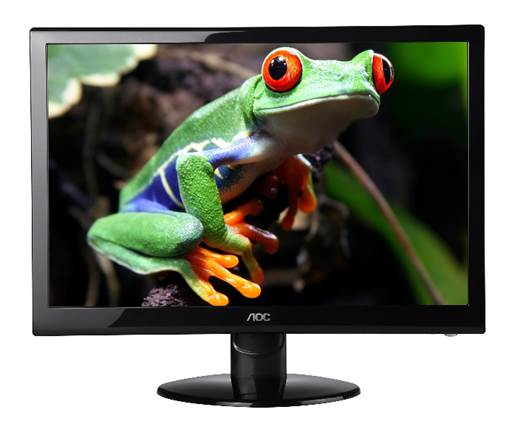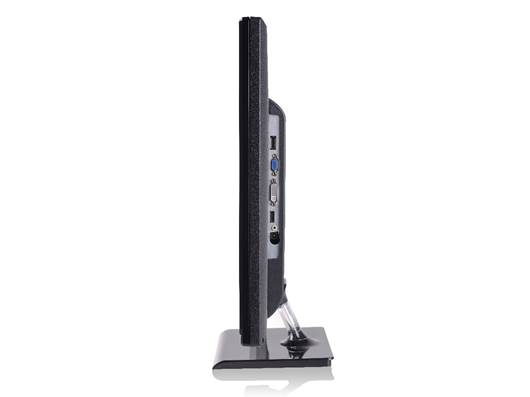A surprisingly capable monitor at a
rock-bottom price
Making the move from a 24in 1,920 x 1,080
monitor up to a 2,560 x 1,440 display can be financially daunting, with
monitors such as the Dell U2713H costing as much as almost triple the price of
a top-quality 24in display. However, the Digimate I PS-2701 WPH breaks this
pattern by offering a large 27in display with a 2,560 x 1,440 resolution for
just $548, and manages to do so without compromising too much on quality.
Despite its low price, the Digimate’s
LED-backlit IPS display doesn’t skimp on inputs (unlike the single
DVI-D-equipped Hazro HZ27WB). DVI-D, VGA, DisplayPort and HDMI inputs are all
included, with the inputs running up the side of the monitor’s rear 1/0 panel.

DIGIMATE
IPS-2701WPH
The screen’s plastic surround is, rather
strangely lightly textured, but it’s also remarkably thin thanks to the use of
an external power-brick, rather than the usual integrated power supply. You’ll
need to find space for the adaptor, but at least you get a thin monitor back in
return.
While the lPS-2701WPH might offer the same
inputs as its top-end competition; however, it compromises heavily when it
comes to its stand. The integrated Perspex stand at the base of the panel is
rather wobbly and, although the glossy plastic base into which it fits is
large, the monitor never feels as stable and secure as we’d like. Thankfully
however, Digimate has seen fit to include a 100 x 100mm VESA mount to the rear
to allow you to wall-mount or fit your own stand, although this will be an
additional expense.
Strangely for a modern display the IPS-2701
WPH’s panel isn’t coated in a matt anti-glare coating, but with a glossy
finish. Matt coatings have the downside of adding a slight grainy effect, but
not reflecting light sources, while glossy coatings have the opposite effect,
making colors, particularly blacks, appear deep and true at the cost of
reflecting any lamp, light bulb or window facing them. The IPS-2701 WPH is no
different, meaning that this screen isn’t ideal for those who plan to use their
monitor in a well-lit or window-filled environment.
On the plus side, the I PS-2701 WPH offers
a halfway decent OSD, unlike the identically priced Hazro HZ27WB, although its
range of settings is nowhere near as wide as the more highly priced
competition. You can adjust the brightness and contrast to suit, and shift from
the standard color setting to cool or warm presets, both of which offer
unusable color temperatures.
The six separate buttons don’t make
navigating the OSD easy either, but thankfully the panel is at its best simply
left alone at its standard setting; there’s genuinely no tinkering required.

Strangely
for a modern display the IPS-2701 WPH’s panel isn’t coated in a matt anti-glare
coating, but with a glossy finish
Performance
At this default setting, the Digimate
IPS-2701WPH produces image quality that far surpassed what we were expecting
from a 2,560 x 1,440 display that costs only $544. The color temperature was
admittedly a little cold at 6.077K, but the gamma levels were excellent, and
only differed from the ideal 2.2 by 0.04 on average. Color accuracy was also
particularly impressive, with an averaged E94 of just 1,8and a maximum of 4.2 -
a result that shames the Dell’s U2713H’s out-of-the-box performance.

This
a surprisingly decent panel at an incredibly tempting price
The only disappointment was the static
contrast ratio of 600:1, which was some way off the stated 1,000:1 and the
lowest of any monitor on test. This was very apparent when viewing fine shades
of black, which were crushed together, losing detail during dark movie scenes.
While the panel supports dynamic contrast, switching it on completely ruins the
color accuracy not to mention the color temperature and gamma, so it isn’t
worth the trade-off.
Any effort to adjust the panel’s color
using the OSD to improve the situation proved fruitless too. The stock
brightness of 250cd/m2, while making the display extremely eye-catching, was
too high for everyday use. However, dropping it to more eye-friendly levels
didn’t compromise the display’s image quality.
With the OSD exhausted, we turned to our
calibration tool and Blue Eye Pro software, which was able to clear up the
color accuracy to an average dE94 of just 0.3 and a maximum dE94 of 1.5,
although the contrast ratio was beyond the software’s abilities.
Running at its optimum settings, the low
contrast ratio still had an effect on black levels, but the I PS-2701 WPH was
otherwise very impressive.
The glossy coating really made colors stand
out, and appear clean and vivid, while the backlight levels were very even,
with just a touch of bleed in the corners. Battlefield 3 looked great with its
bright desert vistas, while video also looked very good for the most part, with
the glossy coating adding sharpness, and skin tones appearing natural; the loss
of depth in blacks was the only complaint.
Conclusion
The Digimate IPS-2701 WPH isn’t a perfect
display. Its low contrast ratio is noticeably lower than the other panels on test
when viewing dark scenes such as those featured in our test video, and its
stand, while sufficient for desks equipped with a monitor platform, leaves much
to be desired.
However, the IPS-2701 WPH’s out-of-the-box
color accuracy and gamma levels are excellent, and the result is image quality
that, overall, makes a mockery of the $544 asking price; even the
any-five-pixel defect policy seems fair when you considering the price you’re
paying for it.
The Dell U2913WM may be a very desirable
monitor, but its (fully justified) $743 price tag is a steep barrier to entry,
while the Digimate IPS-2701WPH’sprice of $544 is far more palatable if you
don’t have a lot of slack in your budget. If you’re able to look beyond its
flaws, this is a surprisingly decent panel at an incredibly tempting price.
|
Information
§ Price:
$544
§ Manufacturer:
www.digimate.com
Specifications
§ Screen
size: 27in/68.5
§ Aspect
ratio: 16:9
§ Screen
area: 311.5in2/2,009cm2
§ Resolution:
2,560 x 1,440
§ Pixel
density (ppi): 108
§ Size
[W x H x D): 645 x 487 x 172 mm
§ Panel
technology: IPS
§ Backlight
type: LED
§ Stated
static contrast ratio: 1000:1
§ Stated
response time (grey to grey): 6ms
§ Inputs:
DisplayPort, DVI-D, HDMI, VGA
§ USB:
4 x USB
§ Adjustment:
Tilt
§ Warranty:
3 years
§ Dead
pixel policy: Any 5 pixel defects
|